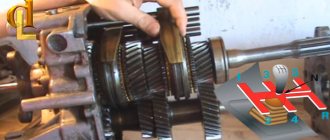Automatic transmission - automatic gearbox or in common parlance - “automatic”, today is perceived as the norm, not like 10-15 years ago. Over the years, the box has seriously evolved, from primitive 4-speed, it has turned into a complex system that can have 6-8 or even 10 gears.
However, the main “diseases” of the machines, unfortunately, have not gone away. In this article you will learn about the main signs of automatic transmission overheating, as well as the causes and consequences that it can cause.
Most breakdowns, be it transmission or engine, occur as a result of violation of the operating rules of a particular unit. With proper use and timely maintenance, any mechanism can last its maximum life. One of the biggest troubles of all automatic machines is overheating; it can perhaps be compared to engine overheating, which also promises trouble and additional costs.
Automatic transmission operating temperature
To reduce friction between working surfaces, automatic transmissions use a special oil (ATF - automatic transmission fluid). Among other things, ATF is also a coolant that removes heat from heating parts and cools, circulates, passing through the oil cooler of the box lubrication system. The operating temperature of the automatic transmission oil is considered to be in the range of 65-100°C. Increasing this threshold is fraught with overheating, with all the ensuing consequences.
Why does the automatic transmission get very hot?
As a rule, if the automatic transmission is in good condition and operates in optimal modes, it facilitates the process of driving a vehicle.
Moreover, even on new cars with an automatic transmission, the owner may encounter the following: Also, the transmission oil in the machine may darken too quickly, etc.
Quite often the cause of such failures is overheating of the automatic transmission. Next, we will look at how to understand that the automatic transmission is overheating, the reasons why the automatic transmission overheats, and also what needs to be done in this case.
Read in this article
So, let us immediately note that a significant increase in the temperature of the transmission oil in an automatic transmission usually manifests itself in the form of certain malfunctions in the operation of the automatic transmission.
Ignoring such symptoms can lead to a reduction in the life of the unit itself or breakdowns. In other words, the automatic transmission in this case often fails, after which an expensive overhaul or repair is required.
- Let's move on. The reasons for overheating of the automatic transmission may be different. First of all, the unit itself contains a large number of loaded elements that interact with each other. As a result, a large amount of heat is generated, which is removed using ATF.
It becomes clear that problems in the automatic transmission or gas turbine engine, deviation from the norm in the oil level in the automatic transmission, a decrease in ATF pressure, as well as loss of properties of the transmission fluid itself lead to an increase in the temperature of the automatic transmission. In some cases, the oil in the automatic transmission heats up to 120 degrees or more.
Such heating is critical, the oil loses its properties, the unit malfunctions, and gearbox wear increases significantly. The consequences of automatic transmission overheating manifest themselves in the form of breakdown, as well as a number of other gearbox elements.
In practice, after a couple of tens of minutes, operating the automatic transmission in maximum heating mode will be enough for the unit to fail. For this reason, it is important to promptly identify symptoms of automatic transmission overheating. In cases where the automatic transmission overheats, signs of excessive heating can be determined independently. If the automatic transmission is very overheated, the transmission can put the unit into .
The check or A/T light on the dashboard indicates problems with the automatic transmission. Various automatic transmission sensors record an increase in temperature, a decrease in ATF pressure, etc. In such a situation, it is not uncommon for the torque converter to literally turn blue from strong heat, the automatic transmission wiring melts, and the clutches burn and crumble.
In this case, when the automatic transmission goes into emergency mode, it is optimal to immediately stop using the car and take it to the service center under your own power, so as not to further worsen the situation. Moreover, if you plan to tow without hanging the drive wheels, then you need to separately take into account all the rules and nuances of such towing a car with an automatic transmission.
- Please note that the machine will not always “fall” into an accident if it overheats. Often the box works, the check is not lit, but the temperature is approaching a critical level. In such a situation, after the automatic transmission reaches operating temperature, the driver usually feels obvious jerks, jolts during shifts, the automatic transmission slips, delays gear shifting, etc. At the same time, the box works fine when cold.
You need to understand that problems cannot be avoided in the future, since constant overheating, even if not critical, significantly reduces the life of clutches and solenoids, and can cause deformations, etc. Under conditions of increased heating, the transmission oil itself also quickly loses its properties and becomes heavily contaminated. This means that the owner must constantly check the level and quality of the oil in the automatic transmission.
It is also important to note any changes in the operation of the unit and immediately carry out diagnostics, promptly change the automatic transmission oil and filter in the automatic transmission, and use high-quality fluids recommended by the transmission manufacturer itself.
If we talk about the reasons why an automatic transmission overheats, the main ones include the following:
- Significant loads on the transmission and severe operating conditions (towing a trailer, frequent and prolonged slipping in mud, snow, etc.)
- Insufficient standard automatic transmission cooling or problems with the automatic transmission cooling radiator;
- Reduced oil pressure in the automatic transmission (contamination of channels, filters, breakdown of the automatic transmission oil pump);
- Low/high, control system malfunctions, problems with solenoids;
At the same time, a frequent and widespread problem is problems associated with the automatic transmission oil cooler (automatic transmission heat exchanger). The fact is that if the radiator is contaminated with deposits and products of natural wear of the automatic transmission, the hot oil ceases to cool effectively in the radiator.
Failures are also possible in the operation of other elements. For example, automatic transmission solenoids are valves that allow ATF to be directed through channels. If the solenoid does not operate in a timely manner, this leads to disruptions in the supply of working fluid, which lubricates and cools the parts.
First of all, if the box overheats, you need to start with diagnosing the automatic transmission. An integrated approach usually allows you to quickly determine the cause and find out why the automatic transmission is heating up.
Often, to eliminate overheating of the machine, you need to clean the valve body channels, change the transmission fluid and filters, and flush the automatic transmission oil cooler. For cleaning, you can use different methods, ranging from using flushes to disassembling the unit.
Another effective way to solve overheating problems is to install an additional automatic transmission cooling radiator with a thermostat. Such a radiator allows you to quickly reach operating temperature and continue to maintain the heating of the oil in the machine no higher than 70-90 degrees.
- Taking into account the fact that many modern automatic transmissions can normally heat up to 100-110 degrees, experienced car owners install an automatic transmission add-on radiator not in case of urgent need, but for the purpose of prevention and increasing the service life of the gearbox.
- Why the automatic transmission kicks, the automatic transmission jerks when changing gears, jerks, jerks and impacts occur in the automatic transmission: the main reasons.
It is a rather complex technical unit. It includes several hundred components that interact with each other and ensure smooth and comfortable acceleration of the car in various driving modes. One such element is a temperature sensor. Read about why it is needed and how it works in this article.
The automatic transmission is designed in such a way that almost all manipulations in it occur with the help of oil injected under pressure. The pressure is pumped up by a special oil pump, which in its structure and design resembles an engine cooling pump and works in a similar way.
The oil circulates at incredible speed. To at least roughly imagine what this speed is, you need to open a water tap and in your imagination increase the pressure and pressure of this water several tens of times.
An inexperienced motorist, and indeed a person who does not repair automatic transmissions on his own, will have a logical question: why is such high pressure needed, and why is it so useful when operating an automatic transmission?
This oil flows through a system of automatically shutting channels called solenoids.
Depending on the path for oil provided by the solenoid, the clutches move under pressure in such a way that they eventually form packages that connect the engine and wheels in a certain way.
When an automatic transmission is operating, the oil inevitably heats up: this is caused simultaneously by high pressure in the oil channels and strong friction achieved when connecting the clutches and their synchronous movement.
The temperature sensor allows the automatic transmission control unit to receive data about the state of the technical fluid in the crankcase and how efficient the entire functional unit is.
Read more: What is the best choice for Korean engine oils?
How it works?
Generally speaking, the meaning of the role played by the automatic transmission temperature sensor is quite transparent.
If for some reason the liquid temperature exceeds the programmed threshold, the control unit makes a chain of decisions.
These solutions are aimed at informing the driver that a problem has arisen and developing actions to restore the functionality of the automatic transmission and its rehabilitation.
For example, on most cars the dashboard is equipped with an automatic transmission overheating indicator. As soon as the sensor is triggered and gives a signal to the control unit, it displays information on the instrument panel, and the driver already understands that something has gone wrong.
On the most modern transmission models, a special algorithm has been implemented, which in emergency cases allows you to bring the transmission back to normal. For example, gears begin to shift more smoothly, and the maximum speed of the car decreases. On top of that, the engine operating mode becomes such that the transmission is not subjected to excessive loads.
For many, it remains unclear where such a sensor is located and what it looks like. In appearance, such a device is a small metal cylinder.
The device is located in the transmission crankcase - the largest amount of oil is located there, and controlling its temperature in this way is much easier and more rational.
Summary
Modern automatic transmissions are necessarily equipped with such a useful device as an automatic transmission oil temperature sensor. Thanks to this, the risk of causing the transmission to fail is greatly reduced, and the service life of all functional elements increases significantly.
An automatic transmission has greatly simplified the process of driving a car. The standard automatic transmission is quite easy to operate and unpretentious to use. With proper care, it can work for quite a long time without complaints.
- The smell of burnt oil in or around the car;
- Kicks when changing gear;
- The switching itself occurs only at high speeds;
- The overheating sensor on the panel is on;
- Or all at once.
How to eliminate automatic transmission overheating?
Repairing a transmission in case of problems with overheating involves diagnosing the automatic transmission cooling system, which makes it possible to determine the cause of the temperature increase. An experienced technician will be able to quickly localize the problem and repair the gearbox in the shortest possible time. In most cases, to eliminate overheating of the automatic transmission, it is necessary to clean the valve body and external heat exchanger. This work presents a certain complexity, since it is necessary to dismantle the hydraulic unit and remove all the pipes that lead from the box to the heat exchanger. Cleaning can be carried out using modern technological means, which allows us to ensure the maximum quality of the repairs carried out. All this allows you to eliminate the problem of overheating.
Cleaning the valve body when overheated
Why does the automatic transmission get very hot?
Despite the fact that a manual transmission is still considered the most reliable and durable, many drivers prefer automatic transmission. It allows you to drive the vehicle in a more comfortable mode and actually takes on some of the tasks.
However, due to the fact that the automatic transmission is a more complex unit, it is not without its drawbacks and often fails. If you ignore the first problems with this unit, you may face serious financial costs (changing a gearbox is not a cheap pleasure).
Overheating of the machine can also lead to destruction of friction discs, solenoids and wiring.
If we talk about the average value, it ranges from 60 to 90-95 degrees. Of course, some transmission components can withstand more severe temperature loads, but if we are talking about the entire system, then you should not exceed the limitations specified by the manufacturer. The maximum temperature that the most modern and expensive automatic transmissions can withstand is 130 degrees.
If the ATF fluid overheats more, it will cause sediment, which will clog some parts of the assembly. In addition, overheating negatively affects the lubricating functions of the oil, which will also accelerate the wear of the automatic transmission. It is impossible to determine the difference in temperature conditions by eye, but there are several methods and recommendations that will help to identify the problem in a timely manner.
The easiest way to determine the occurrence of problems is by characteristic signs. Overheating is most likely to occur if:
- The gearbox began to “kick” with each gear change (the driver feels quite strong jerks).
- Gears begin to shift untimely. Sometimes they may not work at all. There are often situations when it is possible to move from second gear only to fourth.
- A symbol appears on the dashboard indicating that the system is overheating (a check or A/T lights up on the car’s dashboard).
- An unpleasant burning smell appears in the cabin, which comes from transmission oil.
On modern cars, the on-board computer allows you to obtain all the information about the temperature conditions of all necessary components. Therefore, it is worth trying to find information about the fluid in the automatic transmission. If its temperature exceeds 100 degrees, then this indicates obvious overheating.
If the car does not have a function for checking the fluid temperature, then in this case you can buy a simple diagnostic device (the same, Chinese ELM 327) and check the standard indicators of the car via a mobile phone.
Important! If the automatic transmission starts to operate in emergency mode, then it only takes 20-30 minutes for the entire unit to fail. Therefore, when the first suspicion of overheating appears, you need to establish its cause and take appropriate measures.
Most often this happens for several reasons, for which inattentive car owners are to blame:
- Due to untimely change of ATF fluid. The service life of the highest quality trains cannot exceed 150,000 km. It is recommended to change the ATF fluid at intervals of 100,000 km. If we are talking about a modern automatic transmission, then it is better to reduce this value to 80,000 km. A lot also depends on your driving style. If the car owner prefers to press the gas pedal to the floor, often skids, uses a heavy trailer or tows the car, then the transmission oil is changed after 50-60,000 km.
- Due to burnout additives. This leads to the formation of special compounds, which, under the influence of elevated temperatures or loads, begin to interact with metal parts, forming a film of iron sulfide and various combustion wastes on them. If you want to extend the life of the working fluid, then it is better to purchase synthetic oils (they cost several times more) that have improved anti-wear and extreme pressure properties.
- Due to increased loads on the car. When purchasing a car, it is recommended to immediately find out its exact weight and how large trailers or cars can be towed on it. If the towed object exceeds the standard requirements, this can easily cause overheating and rapid wear of the gearbox. Of course, if we are talking about SUVs, then they can easily transport trailers or vehicles weighing up to 2 tons. However, even in this case, the automatic transmission oil will overheat (perhaps to a lesser extent, but there will still be a negative impact). However, if we are talking about a passenger car, then you need to be especially careful.
- When slipping. If a car starts to slip at high speeds on ice, snow or mud, this will certainly lead to severe overheating. Some perform such manipulations on the asphalt intentionally to attract attention, but such a “show” can end disastrously for the automatic transmission. Strong heating will occur in the gearbox, causing the friction discs to burn.
- If problems arise with the gearbox radiator. If it is clogged with dust, dirt, fluff, midges, etc., it will not be able to cope with its main function - cooling the transmission fluid. Therefore, it is important to remember that the radiator must be cleaned at least once a year. Often, car manufacturers combine a cooling element for the engine and gearbox. Such a “joint” radiator does not always cope with its task. Therefore, many install an additional element to cool only the automatic transmission.
- Due to aggressive driving. If your car has an automatic transmission (especially when it comes to old or too cheap cars), then you should not make sharp turns, press the gas pedal to the floor, drift and engage in other manipulations that can easily lead to overheating. Some cars have a special sensor that reduces the supply of gasoline when driving too aggressively. It is designed to limit driving speed and thereby save the driver’s life, and to give the automatic transmission time to “digest” the torque being squeezed out.
Read more: Do-it-yourself repair of a burst bumper
Regardless of the reasons for the overheating of the machine, you should never operate the car in this condition. It is best to call a tow truck, since replacing the entire box will cost much more.
In the future, it is worth more closely monitoring the condition of the automatic transmission, checking it for possible leaks, checking the “freshness” of the oil and how well the cooling system works.
You need to take care of your car and not “force” it to work under extreme loads if it is not designed for this.
But they have several weak points, and if you do not follow the operating rules, then you can very quickly “ruin” this transmission, and the cost of a new one or repairing this one is simply HUGE money! One of the destructive reasons is overheating.
This is exactly what I want to talk about today in more detail. As usual there will be a text version of the video.
Overheating can very quickly damage your automatic transmission, and overheating may not even be noticeable and at low speeds in the city (for example, driving in gentle modes), you won’t even notice it, and when the automatic transmission starts to kick, it will be too late. Today we will talk about the causes and symptoms, and the consequences too.
The machine heats up from the transmission oil (it is special, called ATF fluid).
This fluid is a transmission link - in simple words, it transmits torque from the engine to the wheels.
All this happens in a torque converter, when one turbine (turbine wheel), conventionally tied to the engine, transfers the oil pressure to another turbine, which is tied to the transmission.
As you understand, it is the oil that heats up, and not the automatic transmission itself, and this heat heats up everything else.
In order to level out excess heating of the liquid in the machine, it is passed through a cooling radiator, which is precisely why destructive heating does not occur.
It is worth noting that the normal temperature of the oil inside an automatic transmission is between 65 and 95 degrees Celsius. If the temperature exceeds 100, and even more so 110 degrees, then you already need to think and watch. Otherwise, breakdowns are nearby
Now let's think about what could be the reasons why the machine overheats.
Causes of overheating
The reasons are often trivial and anyone can encounter them:
- The cooling radiator is clogged. Usually it is separate, located next to the main engine cooling radiator. Over time, it can become clogged with lint, dirt, insects, etc. IMPORTANT! Clean it every year (at least wash it with not very strong streams of water)
- The oil hasn't been changed for a long time. Let's say we rode 150 - 200,000 km and never got into an automatic transmission. A VERY large amount of dirt accumulates, and it can also clog the cooling radiator from the inside. ATF fluid will not circulate, so you have overheating
- Towing a car or trailer. A large traction mass can also lead to overheating and greater wear.
- Slipping. Stuck in mud, sand or snow. If you are slipping in one place, the speed is high, the automatic transmission is thoroughly warming up. Many cars even have an overheating protection system, it turns off the machine after critical heating, and you have an indicator on the dashboard
There is another reason, but this is what I call planned aging. The point here is this - on some cars the automatic transmission radiator and the main radiator for the engine are combined. BUT often now motors can be high temperature, which
As long as you don't haul trailers behind you or skid in the mud. Then it is important for you to flush the radiator and change the oil inside on time
Are the consequences most dire for an automatic transmission? Let's go through the points again:
- Oil (or ATF fluid). Its operating temperature (the best one) is up to approximately 130 degrees Celsius. If the heating goes higher, then it simply loses its properties and may even burn. And from such burning, sediment may form, clogging many working parts - solenoids, valve body, etc. At a minimum, the performance of your box will be impaired
- Friction discs (or clutches). I already wrote about them here, they are both hard (usually metal) and soft (can be pressed cardboard and other impregnated types of special paper). So, “soft” clutches can simply collapse from excessively high temperatures.
- Solenoids. In simple terms, these are specialized valves that open the flow of oil to a package of one or another package of friction discs, closing or opening them. So now solenoids can be 50% plastic, and high temperatures can simply destroy them
- Wiring. Often, special control wires can go to the solenoids, but from high temperatures, they can also melt and collapse.
Normal transmission oil temperature
If we talk about the average value, it ranges from 60 to 90-95 degrees. Of course, some transmission components can withstand more severe temperature loads, but if we are talking about the entire system, then you should not exceed the limitations specified by the manufacturer. The maximum temperature that the most modern and expensive automatic transmissions can withstand is 130 degrees.
If the ATF fluid overheats more, it will cause sediment, which will clog some parts of the assembly. In addition, overheating negatively affects the lubricating functions of the oil, which will also accelerate the wear of the automatic transmission. It is impossible to determine the difference in temperature conditions by eye, but there are several methods and recommendations that will help to identify the problem in a timely manner.
At what temperature should the automatic transmission operate?
An automatic transmission contains ATF, which acts as a torque-transmitting link between the engine and the wheels. During automatic transmission operation, the transmission fluid heats up, which can heat up other elements of the gearbox. This can lead to resulting overheating if used incorrectly.
It is believed that the optimal ATF temperature for automatic transmission operation is between 65 and 100 degrees Celsius. If the temperature of the liquid in the box exceeds, there is a high risk of damage to its components.
Please note: A radiator is used specifically to cool ATF fluid in modern cars, through which the fluid flows and is cooled.
- The degree of heating of the “classic” box is related to the quality of the ATF working fluid - the transmission oil in the machine.
- Unlike the motor one, it performs more functions:
- Lubricates the assembly.
- Cools friction areas.
- Protects the structure from corrosion.
- Creates working pressure to compress the clutches, which change gears.
- Transmits torque from the engine to the wheels through a torque converter, i.e. works with the clutch in the automatic transmission.
Under high engine operating loads, ATF heats up to 150℃ and wears out quickly. To prevent overheating, automatic transmission oil passes through a cooling circuit, which lowers its operating temperature to the norm of 75-95℃.
The operating temperature of the automatic transmission oil can be monitored on the car’s dashboard or using the Torque Pro program and the ELM327 adapter. The scanner is connected to the diagnostic connector of the on-board computer and receives data in the application via Bluetooth, Wi-Fi or USB, depending on the model.
Read more: quot start-stop system quot device and principle of operation pros and cons
How to and how not to slip an automatic transmission
Causes of overheating
The main problems leading to an increase in operating temperature are driving style and the quality of car care.
Automatic transmission overheating above 95℃ is observed when:
- pushing in traffic jams;
- driving in hot climates;
- slipping at high speeds;
- towing a trailer or car;
- going uphill.
If the operating temperature of the automatic transmission increases when driving without load, then the reasons may be the following:
- the main cooling radiator is dirty;
- automatic transmission radiator clogged;
- the oil level is below or above normal;
- It hasn't been changed for a long time or the wrong fluid has been added.
Radiator problems
The cooling capacity of the radiator in hot weather and in traffic jams is reduced because the air flow for blowing is too weak. In addition, the heat exchanger honeycombs are constantly clogged with debris arriving from outside: fluff, insects, dust. As a result, the radiator does not fully dissipate the vehicle's heat, and the operating temperature rises.
The automatic transmission cooling circuit is built into the engine radiator. Taking into account the fact that antifreeze in the main heat exchanger can heat up to 100℃, the radiator of the machine will not be able to cool the ATF to the required operating temperature.
Increased loads
Automatic gear shifting during prolonged slipping leads to high system overloads: in pursuit of transmitting high torque, the operating temperature of the oil in the torque converter quickly increases.
Oil quantity
If there is a lack of ATF, the pump picks up air. The resulting oil-air emulsion has a low heat capacity, is easily compressed, and the quality of the lubricant decreases. Due to high friction, the operating temperature of the automatic transmission begins to rise.
If there is excess liquid, then at high speeds it foams, increases in volume and splashes out. As a result, the oil level decreases and the situation described above occurs.
ATF quality
Manufacturers regulate partial or hardware replacement of automatic transmission fluid every 60,000 km. Taking into account the change of seasons, the quality of roads and driving style, the frequency of oil changes should be reduced to 30-40,000 km.
Do-it-yourself complete and partial oil change in automatic transmission Suzuki SX4
What will happen if you ignore the recommendations: after 100,000 km, the oil will become saturated with slag and metal shavings, lose its properties, and the unit will stop working normally.
Symptoms of overheating
If the operating temperature of the automatic transmission is exceeded, the overheating or fluid level pressure drop light on the on-board computer panel will indicate. If the oil indicator color does not light red, then the condition of the automatic transmission may indicate its behavior. To better understand the relationship between symptoms and the causes of their occurrence, the information is summarized in a table.
| Problem | Cause |
| Shocks when changing gear | Heated oil, contaminated with wear products, clogs the solenoids and thin channels of the valve body, which leads to a drop in pressure. The friction discs stop compressing and slip against each other, which leads to rough operation of the box. |
| Gear shifts are delayed | |
| Upshift is reset to downshift | |
| Burnt oil smell | ATF started to burn. |
Providing first aid when signs of an increase in operating temperature appear will help maintain the functionality of the unit.
In this case, you need to reduce the speed and wait until the automatic transmission has cooled to normal operating temperature and the light goes out.
It is recommended to clean the outside of heat exchangers at least once a year. Dirt is washed off with jets of water under pressure or a mini-wash, the main thing is not to damage the honeycombs with high pressure. For greater effectiveness, use car shampoos.
The oil level and quality are checked with the engine running and the selector in position “P”, having previously driven 10-20 km. The top marks on the dipstick labeled “Hot” indicate the correct ATF level.
Automatic transmission oil differs from other fluids in red or light yellow color. When checking with a dipstick, the red color indicates the good condition of the oil. Increasing shade to dark indicates levels of dirt and wear. Black - signals aging and unfitness.
You can change the oil completely using the device or partially even in maintenance-free boxes. For a partial replacement, remove and wash the pan, drain up to 50% of the liquid, change the oil filter, install the pan and fill in fresh oil in the amount drained. The procedure is repeated 2-3 times.
If the ATF has recently been changed to a different brand, it is possible that it is not suitable in viscosity and does not cope with the operating temperatures of the transmission. You can view the manufacturer's recommendations for choosing a composition on the automatic transmission dipstick, on the table under the hood and in the instructions.
If none of the options help, and the operating temperature does not drop to normal 75-95℃, you need to diagnose the car.
Why does the automatic transmission overheat?
Automatic transmission fluid has a working temperature threshold in the range from 70 to 90 degrees. Modern manufacturers of cars and fluids for automatic transmissions have decided to increase this indicator to 100-110 degrees, thus reducing the service life of automatic transmissions. Considering that during regular driving of a car, the radiator may become clogged, the gearbox may overheat due to an insufficient level of coolant, or malfunctions may occur related to the operation of the pump or thermostat, the transmission may fail even before the driver has driven 100 thousand kilometers.
If the automatic transmission receives an even higher temperature load, destruction of other elements of the system is inevitable, because its metal parts are simply deformed, which entails a loss of their functionality and further failure of the transmission itself.
Operating oil temperature in automatic transmission: causes, symptoms and consequences of box overheating
The service life of an automatic transmission will exceed 300,000 km if you regularly care for the unit and monitor such indicators as the operating temperature of the automatic transmission. Ignoring high values leads to a car accident, repair or complete replacement of the box. Knowing the reasons for the temperature increase, you can prevent the occurrence of a malfunction and secure the control.
Why does overheating occur?
- Due to untimely change of ATF fluid. The service life of the highest quality trains cannot exceed 150,000 km. It is recommended to change the ATF fluid at intervals of 100,000 km. If we are talking about a modern automatic transmission, then it is better to reduce this value to 80,000 km. A lot also depends on your driving style. If the car owner prefers to press the gas pedal to the floor, often skids, uses a heavy trailer or tows the car, then the transmission oil is changed after 50-60,000 km.
Regardless of the reasons for the overheating of the machine, you should never operate the car in this condition. It is best to call a tow truck, since replacing the entire box will cost much more. In the future, it is worth more closely monitoring the condition of the automatic transmission, checking it for possible leaks, checking the “freshness” of the oil and how well the cooling system works. You need to take care of your car and not “force” it to work under extreme loads if it is not designed for this.
Is it necessary to warm up the automatic transmission in winter, why and how to do it correctly?
Most car owners seem to have made up their minds about warming up the engine and warm up the engines correctly: a little at idle and then at low load while driving. In general, it is clear why warming up is needed and how “cold” loads affect the engine’s service life. Public consensus has yet to be reached regarding ACP. Someone accelerates in “parking”, someone goes through all the selector positions while holding the brake pedal, someone starts moving at low speed... But how is it really necessary, and is it even necessary at all?
Let's start with the main thing: warming up is necessary. The reasons for this are even more obvious than in the case of the motor. As the oil temperature increases, the viscosity and lubricating properties change, and this relationship is nonlinear. For those wishing to look at the graphs, we recommend one of our previous publications on engine oil viscosity. For transmission oils, including ATF (automatic oil), the relationship is the same: the viscosity of cold oil is hundreds of times higher than the viscosity at operating temperature, which greatly increases the load on a number of gearbox components. As a result, the oil pump, solenoids, torque converter blades and much more suffer from cold operation.











